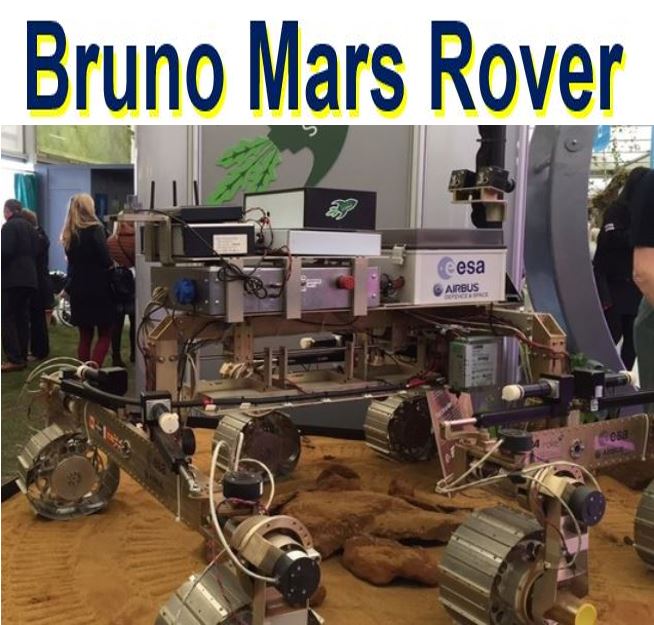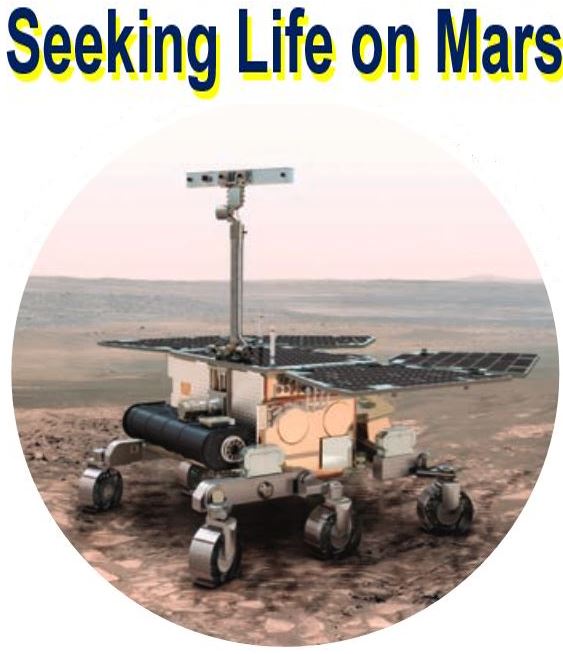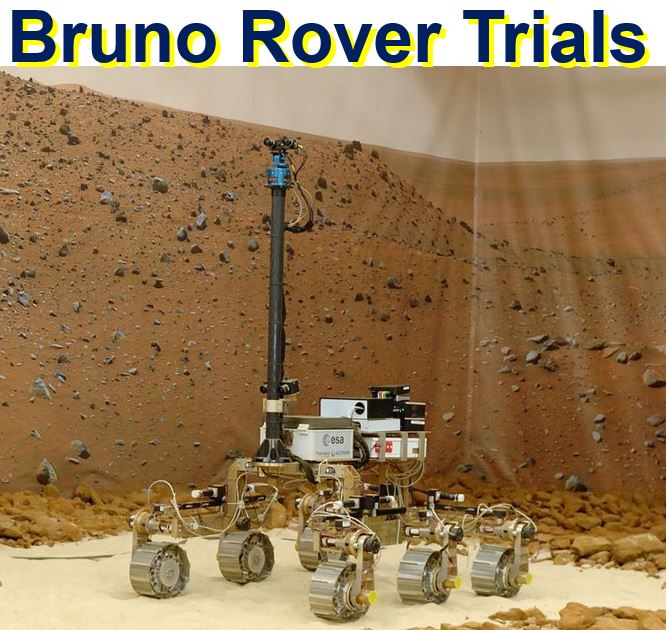Bruno Mars, the UK-made rover, could become the first device to detect life on the Red Planet as part of the ExoMars European Space Agency mission, beating America’s NASA to the post, say its creators in Stevenage, Hertfordshire, England.
Bruno Mars, made by Airbus Defence and Space Ltd., is part of the £946 million project to send a robot to Mars in 2018. Unlike previous rovers, this one will be able to plot its own path without having to wait for instructions from controllers back on Earth.
Bruno’s problems with shadows
However, the cutting-edge device has one major problem it needs to overcome – shadows sometimes confuse it. That is why scientists are asking our man in space – Major Tim Peake – to help overcome the robot’s confusion over shadows.
 The Bruno Mars rover will find its way over the Martian terrain using autonomous navigation to avoid boulders and other obstructions, rather than relying on direct control signals from Earth. (Image: esa.int)
The Bruno Mars rover will find its way over the Martian terrain using autonomous navigation to avoid boulders and other obstructions, rather than relying on direct control signals from Earth. (Image: esa.int)
Bruno can produce its own 3-dimensional map of the area it plans to explore and plots its own route. The only trouble is that when it comes across large shadows created by caves and craters, it can make mistakes.
Dr. Ralph Cordey, head of science at Airbus Defence and Space Ltd., said regarding Bruno’s mobility:
“It’s not possible to drive this sort of machine with a joystick. You’ll crash it. So this rover is designed to be semi-autonomous. It can produce its own 3D map of the area ahead of it, look where it’s being asked to go, and plot its own path.”
Dr. Cordey and colleagues have now asked Major Peake to remotely steer the robot in tests in their quest to find an effective solution.
 According to the UK Space Agency, the rover will perform tests on the planet’s geology, geochemistry and exobiology – searching for evidence of environments that may once have supported life. The UK is the second-largest contributor to the ExoMars mission. (Image: UK Space Agency)
According to the UK Space Agency, the rover will perform tests on the planet’s geology, geochemistry and exobiology – searching for evidence of environments that may once have supported life. The UK is the second-largest contributor to the ExoMars mission. (Image: UK Space Agency)
During a series of trials, Major Peake, who has been at the International Space Station (ISS) orbiting the Earth since December, will be operating Bruno remotely.
Scientists have created an artificial cave, which they say replicates conditions on the Red Planet. Major Peake will be driving the robot into the cave where he will try to seek out targets that have been marked with an ‘X’.
Jeremy Close, who is in charge of communications at Airbus Defence & Space, said:
“There are caves on Mars and craters that cast long shadows. To explore those areas, it’s more efficient to have a human in the loop.”
Bruno trials in testing ground
The Bruno science team has created a testing ground in a giant hangar consisting of 250 tons of sand, artificial boulders and panoramic photos of the Red Planet.
One of the greatest challenges when using equipment in a Mars mission is the distance – radio signals do not come to Earth and go back instantly. Radio signals can take from 4 minutes to 24 minutes to get to Earth from Mars and vice-versa.
 One of Bruno’s many demonstrations in front of journalists in a specially constructed mock-up of a Martian landscape (Mars yard) at the company’s Stevenage site. A company spokesman said: “If we have more autonomy on board, we can do more science in the same timescale and hopefully also travel larger distances within the same timeframe.” (Image: space-airbusds.com)
One of Bruno’s many demonstrations in front of journalists in a specially constructed mock-up of a Martian landscape (Mars yard) at the company’s Stevenage site. A company spokesman said: “If we have more autonomy on board, we can do more science in the same timescale and hopefully also travel larger distances within the same timeframe.” (Image: space-airbusds.com)
This means that at its longest distance, getting a signal from Mars to Earth and another one back can take over 40 minutes.
Dr. Cordey said:
“It’s not possible to drive this sort of machine with a joystick. You’ll crash it. So this rover is designed to be semi-autonomous. It can produce its own 3D map of the area ahead of it, look where it’s being asked to go, and plot its own path.”
“It’s aware that some rocks it can’t get over and has to drive round, and it can see ditches and sense what slopes are safe to climb.”
A rover that operates independently
Bruno, unlike other planetary Rovers, while not have to wait around for long periods for control instructions to come from scientists back on Earth. It will be able to decide independently what course to take on Mar’s surface, which is uneven and full of boulders.
 Bruno’s GNC system converts images of his surroundings captured by two cameras on top of its two-metre mast into a 3-D terrain model, and then applies algorithms to create a ‘navigation map’, plotting out a path which avoids obstacles to take it to its designated destination. (Image: space-airbusds.com)
Bruno’s GNC system converts images of his surroundings captured by two cameras on top of its two-metre mast into a 3-D terrain model, and then applies algorithms to create a ‘navigation map’, plotting out a path which avoids obstacles to take it to its designated destination. (Image: space-airbusds.com)
All its human controllers will have to do is provide the coordinates of a target location. How to get there will be decided by Bruno.
Engineers will begin assembling the final model later in 2016. It will be sent to Mars as part of the ExoMars mission, which blasted off from Earth last week.
There is currently a family of three rover prototypes – Bryan, Bridget and Bruno, the ‘B’ triplets. Bruno is the second propotype.
A rover with a drill and a lab
In 2018, a six-wheeled machine with a Bruno-like ‘brain’ will be launched to Mars. It will seek out signs of life as we know it in soil samples, searching up to six feet below the planet’s surface. It will also take colour photographs of the surrounding landscape.
The completed rover will have a drill that will be able to bore down over six feet below the Red Planet’s surface and gather samples which will be analyzed within its own little laboratory.
The ExoMars rover will be the first explorer to look for biochemical signs of life on Mars.
Dr. Cordey added:
“It will have the ability to put you there in a 3D colour environment, as if you were on Mars. It will help answer one of the really deep down questions that we have. You stop and look up into the night sky and wonder, is there life out there?”
“We’ve now got the engineering and science capability to start trying to answer that question. It’s not just in the realms of sci-fi – there are good reasons for believing there could have been life on Mars early in its life, just as there was on Earth.”
Minister for Universities and Science, Joseph Edmung Johnson (Jo Johnson), member of parliament for Oprington, said:
“It’s fantastic that technologies developed and built in the UK will soon be exploring the Red Planet, helping answer the question of whether there was ever life on Mars.”
“We want the UK to be at the forefront of major discoveries like this, which is why we are one of the biggest contributors to the Exo-Mars project through the European Space Agency.”
Video – Bruno Rover Goes It Alone
This Airbus Defence & Space video shows a simulation of what Bruno would be doing on Mars.

